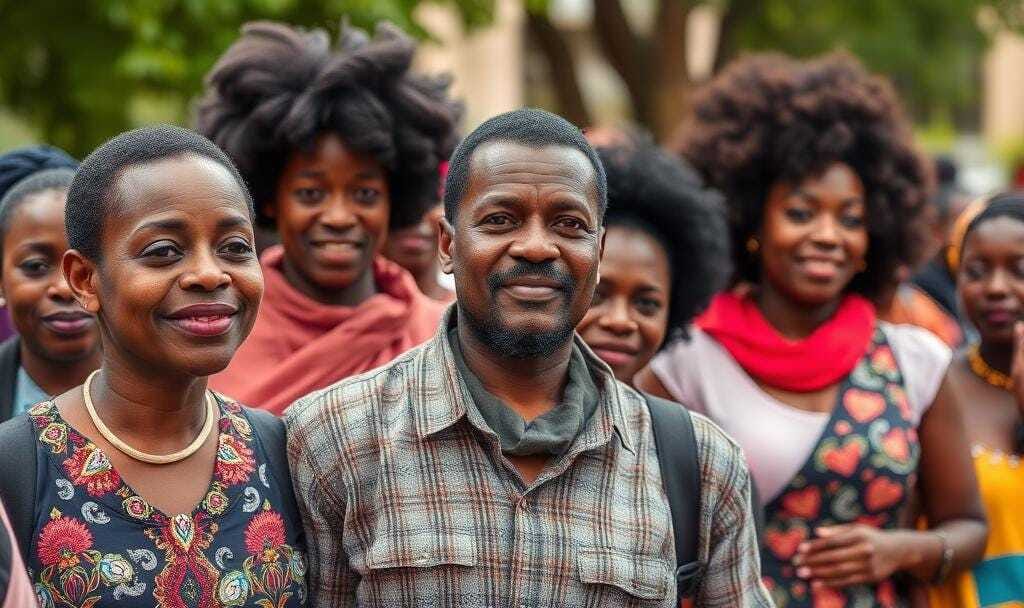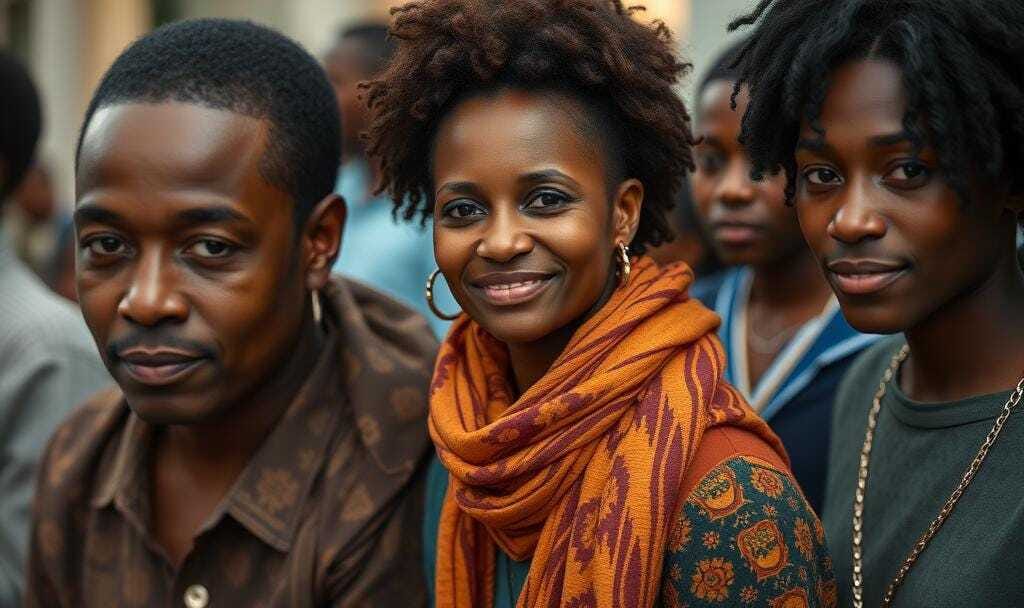Abstract: The question of “who is a real African American Black person?” is a deceptively simple inquiry that, upon academic examination, reveals a complex interplay of history, culture, identity, and social construction. This paper argues that there is no singular, monolithic definition of “real.” Instead, the identity of “African American Black people” is fluid, multifaceted, and constantly negotiated. We will explore the historical trajectory of this identity, from its roots in the transatlantic slave trade and forced dispersal across the Americas to the ongoing struggles for recognition and self-determination. Key themes to be examined include the centrality of ancestry and lineage, the significance of shared cultural experiences and traditions, the impact of systemic racism and its shaping of identity, and the evolving nature of self-identification in contemporary society. Ultimately, this paper posits that “real” African American Black people are those who identify as such and engage with the historical, cultural, and social realities that have shaped this unique group, while acknowledging the inherent diversity within this broad category.

Introduction:
The term “African American” has become a widely recognized descriptor for Black people in the United States, carrying with it a rich, albeit often painful, historical and cultural legacy. However, the addition of the qualifier “real” introduces a layer of complexity and potential exclusion. This paper deconstructs the notion of “real” in relation to African American Black identity, arguing that such a definitive label is not only problematic but also fails to capture the lived experiences of a diverse population. To understand who constitutes “real” African American Black people, we must delve into the historical forces that forged this identity, the cultural elements that bind it, and the ongoing socio-political context that shapes its present and future.
I. Historical Foundations: From Enslavement to Self-Definition
The genesis of the African American identity is inextricably linked to the brutal institution of chattel slavery in the Americas. Millions of Africans, ripped from their diverse homelands and cultures, were forcibly brought to the United States. This shared trauma of enslavement, the stripping of individual identities, and the systematic dehumanization became a foundational, albeit tragic, common ground.
Lineage and Ancestry: For many, the concept of “real” African American identity is rooted in demonstrable ancestral ties to individuals who were enslaved in the United States and their descendants. This ancestral connection serves as a historical marker, distinguishing those whose lineage directly traces back to this specific historical experience from those who may share racial or cultural affinities but lack this particular historical connection. While DNA ancestry testing can provide insights, it often cannot definitively prove lineage to enslaved individuals in the US, highlighting the limitations of purely biological markers.
The Middle Passage and the Atlantic Slave Trade: The shared experience of the Middle Passage, the horrific journey across the Atlantic, and the subsequent forced labor on plantations created a collective memory and trauma that continues to inform African American identity. The survival and resilience in the face of such unimaginable brutality are central to this historical narrative.
Post-Emancipation Struggles: Following emancipation, African Americans faced continued oppression through Jim Crow laws, segregation, and economic exploitation. The fight for civil rights, voting rights, and basic human dignity further solidified a sense of collective identity and purpose. This ongoing struggle for liberation and equality is a crucial element in understanding who identifies as African American.
II. Cultural Tapestry: Shared Experiences and Expressions

Beyond ancestral ties, shared cultural experiences, traditions, and expressions are vital components of African American identity. These cultural elements, forged in the crucible of oppression and resilience, have created a unique and vibrant heritage.
Language and Vernacular: African American Vernacular English (AAVE), with its distinct grammar, vocabulary, and pronunciation, is a powerful marker of shared cultural heritage. While not universally spoken by all African Americans, AAVE has played a significant role in shaping linguistic landscapes and is often seen as a linguistic manifestation of Black identity.
Music and the Arts: From spirituals and blues to jazz, R&B, soul, hip-hop, and gospel, Black music has been a cornerstone of African American culture, serving as a form of expression, resistance, and communal bonding. Similarly, African American literature, visual arts, and dance have provided platforms for storytelling, social commentary, and the affirmation of identity.
Religious and Spiritual Traditions: The Black Church has historically served as a vital institution for community building, spiritual guidance, and political mobilization. Shared religious experiences and beliefs have been instrumental in shaping the moral and social fabric of African American communities.
Cuisine and Culinary Heritage: The unique culinary traditions of African Americans, born out of necessity and creativity during slavery and beyond, represent a tangible and delicious aspect of cultural heritage.
Community and Kinship Networks: Despite geographical dispersion and varying socioeconomic statuses, strong community ties and extended kinship networks have historically been crucial for survival and mutual support within African American communities.
III. The Social Construction of Race and Identity
The concept of “race” itself is a social construct, not a biological reality. However, the social and material consequences of this construct are profoundly real. The categorization of individuals as “Black” has been historically enforced by dominant societal structures, often with oppressive intent.
The “One-Drop Rule”: Historically, the “one-drop rule” in the United States dictated that any discernible African ancestry made an individual “Black.” This legal and social construct, designed to maintain racial hierarchies, meant that individuals with very little acknowledged African ancestry were still classified and treated as Black. This rule highlights the arbitrary and socially imposed nature of racial categorization.
Systemic Racism and its Impact: The legacy of slavery, Jim Crow, and ongoing systemic racism has profoundly shaped the experiences and identities of Black people in America. Racial profiling, discrimination in housing, employment, and the justice system continue to impact how Black individuals are perceived and how they navigate society. This shared experience of encountering and resisting racism is a powerful unifying force.
Internalized Racism and Identity: The pervasive nature of racism has, at times, led to internalized biases and anxieties about identity, even within Black communities. Navigating these internal complexities is part of the ongoing process of self-definition.
IV. Evolving Self-Identification in Contemporary Society

In the 21st century, the definition of who is an “African American Black person” is increasingly characterized by self-identification and a broader understanding of identity.
Self-Identification as Paramount: Ultimately, the most crucial factor in determining who is an “African American Black person” is self-identification. Individuals who identify as African American, irrespective of the degree of their perceived “Blackness” or specific ancestral connections, should be recognized as such.
Intersectional Identities: Contemporary African American identity is increasingly understood through an intersectional lens, acknowledging how race intersects with gender, sexuality, class, religion, and other aspects of identity. This recognition expands the understanding of who can be an African American Black person, embracing the diversity of experiences within the community.
The Diaspora and Transnational Connections: While the term “African American” primarily refers to Black people in the United States, there is a growing awareness of and connection to the broader African diaspora and transnational Black communities. This can lead to a more fluid understanding of identity for some individuals.

Debates and Distinctions: It is important to acknowledge that there are ongoing discussions and debates within and outside Black communities regarding identity. Distinctions are often made between African Americans born and raised in the US with ancestral ties to slavery, and Black immigrants from other parts of the African diaspora, while acknowledging shared experiences of racism and cultural exchange. However, these distinctions do not negate the validity of self-identification.
:
The question of “who is a real African American Black person?” is an invitation to explore a rich and complex history, a vibrant culture, and a continuously evolving social identity. There is no singular, static answer. Instead, the identity of “African American Black people” is a dynamic tapestry woven from threads of ancestral lineage, shared historical experiences of oppression and resilience, a distinct cultural heritage, and the ongoing process of self-definition.
To be a “real” African American Black person is to acknowledge and engage with this historical legacy, to participate in and appreciate the cultural expressions that define the community, and to navigate the ongoing realities of race and racism in America. It is to embrace a shared identity that, while encompassing significant diversity, is rooted in a common journey of survival, resistance, and the enduring pursuit of self-determination. The term “real” ultimately becomes less about exclusion and more about a recognition of a deeply rooted, historically shaped, and personally embraced identity. The power of this identity lies not in its exclusivity, but in its profound capacity for inclusion, understanding, and the celebration of a unique and vital part of the American and global human experience.
